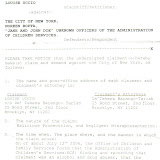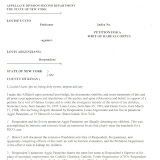The headlines read: Eight Year-Old Kills Father and a Boarder. Was this tragedy preventable? If it is proven that the known causes of youth violence were there, it was entirely preventable. This is worse than a tragedy and it must be fixed.
Experts agree that most youth who become violent share certain elements in their histories. These include a history of trauma, such as child abuse, neglect, and exposure to domestic violence, (especially as a young child).
Disrupted attachment patterns from maladaptive caregiving, neurological impairment, dual diagnosis of mental illness and substance abuse, delayed skill development in vital life skill areas, and a history of violence or aggression are also associated with violent behavior in children. Research supported by The Office of Juvenile Justice and Delinquency Prevention shows that youth with more than 5 of the established risk factors for violence and fewer than 6 protective factors have an 80% greater risk of violent behavior.
In addition to the above, risk factors include school difficulties, poor social or problem solving skills, family violence, and deviant peers. Resiliency factors consist of participating in effective therapy, engaging in pro-social activities, and caregivers having adequate treatment for their own issues.
Childhood trauma, such as abuse, neglect or exposure to violence, if not sufficiently treated, can result in symptoms of depression, ADHD, and PTSD, as is seen in the work of S. Braaten, B. Van der Kolk, and many others. Dr. Van der Kolk also asserts that trauma can interfere with the development of appropriate coping skills, such as problem solving, interpersonal, communication, task, self management, and adaptive skills. Reducing the risk of future violence, involves stopping and resolving trauma and building skills to an age appropriate level.
Thirty years of research on risk and resiliency factors and treatment outcomes has resulted in the development of the risk assessment, the CARE2: Chronic Violence Risk and Needs Assessment and intervention system used in many parts of the US and Canada. The CARE2 is a valid, reliable, and systematic way to assess the risk and needs of youth and his/her family. This prevention tool will determine appropriate interventions for the youth and the family to prevent future violence and other acting out behaviors.
In the case of the 8 year old who shot his father and neighbor, issues of suspected child abuse, domestic violence, and strained relationships between the child and both parents have now been raised. A complete investigation of these allegations and the youth's developmental level of coping skills will paint a picture of the history of events which led to this horrible outcome. The Judge has accepted a plea agreement in this case, which will allow the youth to get treatment.
Intervening early in environments of family violence can prevent such tragedies from occurring. Children who come to the attention of child protective services and those in homes with domestic violence should be screened for treatment needs.
Children need to be well bonded to their parents or caregivers to learn the skills they need for appropriate social interactions. For example, a father who spanks excessively and a mother who does not appear to be in the child's everyday family group raise red flags that need investigation. Children who do not have strong pro-social family attachments to their caregivers do not internalize reciprocity, empathy, or the need to follow rules to be an effective member of a school or family group.
If strong pro-social attachments or developmental skills are missing they must be built in an appropriate developmental sequence. We learn to sit before we stand, and stand before we walk, and walk before we run. Interpersonal skills also follow a predictable pattern, with each skill built on the mastery of the one before it. If a youth's survival depends on putting all of his energy, and brainpower into safety and stress management, there is little left to put in acquiring skills such as empathy, self-management, communication and social skills. Those skills can become stunted.
So, what is the answer to "How do we prevent future youth violence?" Violence is, in part, a trauma matter and a developmental skills issue. So when there is violence in the household, it is often because people lack the skills to do things differently from how they were raised. Growing up in a violent environment skews one's ideas of right and wrong. Higher intensity services and a more structured environment are needed for youth who are greatly at risk for committing acts of violence against themselves and/or others. This also allows the system to focus the most intensive and thus expensive services on youth and families with the greatest needs. The families also need support services to improve skill levels and prevent family violence.
Dr. Kathryn Seifert has over 30 years experience in mental health, addictions, and criminal justice work. She authored the CARE2, How Children Become Violent, and numerous articles. Dr. Seifert has lectured internationally on youth and family violence and trauma. Dr. Kathy Seifert
8 Year Old Child Killer: Criminal, Mentally Ill, or Trauma Victim Content for Reprint
Refresh - Go to homepage
Subscribe to:
Post Comments (Atom)























No comments:
Post a Comment